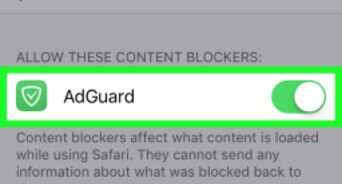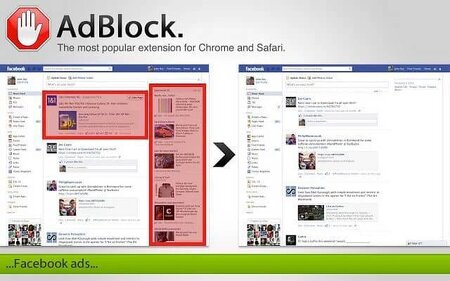I would love to have a partial ad-blocker, which would only block ads that are known to be malicious. I’m also fine with obtrusive ads (flash, gif, videos, etc.), that are not malicious, just trying to grab attention, so Adblock Plus’s lesser filter is still not okay for me. If it’s a Chrome Extension, and you allow it to access your data on all pages, then it can do all those things. Almost all Chrome Extensions ask for this permission, and with AdBlocker it’s required even to work, if you think about it. The online experience can be a jangling, ad-filled mess if you don’t have good ad-blocking software running.
Where is the ad blocker on Google Chrome?
In Google Chrome In the drop-down menu, select “Settings”. Next, go to the tab “Extensions” on the left side of the screen. This will open the extension window of Google Chrome, where you will find Adblock Plus. Under the description, you can find the “Options” hyperlink.
Just remember to unblock sites you wish to support financially. Back in January, Google announced a proposed change to Chrome’s extensions system, called Manifest V3, that would stop current ad blockers from working efficiently.
As far as functionality goes, Trustnav presents a very easy-to-use adblocker with a great user interface. However, the biggest problem you’ll find with this adblocker is that you can’t adjust many settings. Trustnav lets you toggle whether the adblocker is on or off, whether it is blocking all ads or just some ads, and whether you want to get alerts.
Getting started with Adblock Plus
We also know that Google dodges these extensions somehow in Chrome so some ads still get through. However, both block the vast majority of ads, popups, text ads, flashing banners, video ads and pop-under ads. All of the options mentioned above are very resource lite, especially the ones that are browser extensions.
Does Chrome have AdBlock?
The original AdBlock for Chrome works automatically. Choose to continue seeing unobtrusive ads, whitelist your favorite sites, or block all ads by default. Just click “Add to Chrome,” then visit your favorite website and see the ads disappear!
So it is not necessary to “uninstall” this tool to not be banned by Google. Since many websites rely on advertising revenue, Adblock Plus’s default settings encourage the use of nonintrusive advertising rather than annoying, irrelevant ads. With that in mind, the change makes a great deal of sense, when you think of Chrome as a way for Google to better deliver ads to your devices. By allowing in-depth ad blockers to continue to function, they’re allowing for a direct, negative impact on their largest revenue stream. Chrome’s enterprise users get an exception, likely because they’re a separate revenue stream.
However, be sure to double check the history and safety of any developer whose program you choose to install as a plugin on your browser. Before you dive into blocking ads on your favorite websites, we’d like to point out that those websites you’re using often rely on ad revenue to survive.
Trustnav also currently has a “Safesearch” Chrome and Firefox plugin that’s separate from the adblocker. Be sure to install the adblocker version directly from the Chrome or Firefox. As far as we can tell, the only ad blockers left on the Google Chrome Store are fully legitimate. All of the Chrome plugin options that are currently on our list passed Google’s vetting process.
host-file ad blockers are usually the least efficient, they can’t block most ads without breaking websites and they rely on an OS feature that was never designed for more than a handful of addresses. From here, we recommend you to deactivate any extension or application that blocks ads on YouTube. Remember that you can add exceptions so that the app or extension does not work on certain websites.
Your best ad blocking option is to install a browser plugin or utilize a web browser that already has a built-in blocker. Browser plugins or built-in ad blockers can interact with the websites you’re using much more accurately than a standalone program operating on your computer in the background. The obvious main benefit of using and ad blocker is, well, no ads. Firefox is available on all platforms (including Chrome OS via the Android or Linux app) and, unlike Chrome, supports browser extensions on Android, including uBlock Origin and other privacy extensions.
Adblock Plus
A new addition to the pop-up blocking scene, Poper Blocker is available for both Chrome and Firefox web browsers. This plugin has been hailed as the best pop-up blocker on the market by several other tech sites, which is a fair claim, although not necessarily the case from our testing. Poper Blocker is a high-tier option to explore nonetheless as it’s very effective at what it does.
With ads becoming more invasive and more annoying, ad blockers are a growing industry and have gone from being a convenience for power to users, to being an absolute necessity. Add the potential for malware injection from hacked or compromised ads and you have every reason to block them. Two of the biggest names out there right now are Adblock and Adblock Plus. Despite their nearly identical names, the two products are unrelated, although both do much the same thing in a very similar way.
You may have heard of the popular ad blockers Privacy Badger and Ghostery. While we like and respect these two ad blockers, neither met our criteria based on how they function. Neither of these plugins is designed to block ads, specifically, but to deny website ads and other website elements that betray user privacy. As a result, both will block some ads some of the time but are primarily focused on privacy instead of complete security online.

- The Stands Fair AdBlocker is not designed for wholesale ad blocking, although you can use it for that.
- This Chrome-only ad blocker is a low-impact plugin that does exactly what it’s intended to do.
- You can block all types of ads using this plugin, with the most obvious limitation being that it’s only available as a Chrome addon.
With over 10 million downloads on the Chrome browser alone, Adblock Plus is the most popular ad blocking software around. Adblock Plus is the primary source code for a lot of other free ad blockers around here.
AdBlocker Genesis Plus is a fork of other popular plugins, meaning it uses the same basic code which alters enough to be a unique program. The UI is slightly different, but the ad blocking functionality is mostly the same. More notably, this ad blocker’s developer says he specifically removed tracking code from the original uBlock/AdBlock Plus code in order to ensure more privacy.
Installing Adblock Plus
Both are r bveasonably good at blocking the majority of ads. The results are muddied somewhat by the ‘acceptable ads’ situation. We know some companies pay both extensions to whitelist their ads.
Chrome is a known resource hog, especially, so I would recommend an adblocker running on either Opera or Firefox. Trustnav is an antivirus company from Andorra that provides a combination adblocker and antivirus Google Chrome plugin. The antivirus solution, which is premium and costs $1.99 per month, is currently unavailable. If you’ve used or are interested in the uBlock Origin or AdBlock Plus style of ad blockers, this plugin may be for you.
In Google Chrome
This Chrome-only ad blocker is a low-impact plugin that does exactly what it’s intended to do. You can block all types of ads using this plugin, with the most obvious limitation being that it’s only available as a Chrome addon. The Stands Fair AdBlocker is not designed for wholesale ad blocking, although you can use it for that. The company believes in fair advertising and encourages users to whitelist certain ads from different sites.
Google is essentially saying that Chrome will still have the capability to block unwanted content, but this will be restricted to only paid, enterprise users of Chrome. This is likely to allow enterprise customers to develop in-house Chrome extensions, not for ad blocking usage.
Ad blockers are one of the best ways to help secure your privacy online, reduce clutter on websites, and avoid spyware-infected ads. Although it’s certainly possible to find a paid ad blocking software, there’s no reason to spend money on one. This list of the best free ad blockers includes a mixture of highly-effective tools for Chrome, Firefox, and more. Another open source project, AdBlocker Ultimate is good at removing most ads you might come across. In testing, it was able to dispel ads on YouTube and most display ads on various sites we tested.
That said, uBlock Plus Adblocker effectively stopped all of the ads we tested, including autoplay videos. We initially also tested for prestitial and interstitial ads (those that load a screen before your content and often include a countdown). We only mention these where available, but did not include them in rating considerations. The best free adblockers, such as AdLock, Incognito Adblocker, and uBlock, are those that prevent all types of ads while also ensuring your privacy.
Beyond that, there’s no fine tuning, no real whitelisting, and no way to view all of your adblocking stats outside of how many ads were blocked on the site you’re visiting at the time. Trustnav also currently has a “Safesearch” Chrome plugin that’s separate from the adblocker. Be sure to install the adblocker version directly from the Chrome. The biggest drawback to this plugin is that it’s less user-friendly in the forward-facing interface. There are a few setting toggles in the UI, but most of the grunt work needs to be done in the actual settings.
Now, months later, Google has responded to some of the various issues raised by the community, sharing more details on the changes to permissions and more. The most notable aspect of their response, however, is a single sentence buried in the text, clarifying their changes to ad blocking and privacy blocking extensions. Manifest V3 comprises a major change to Chrome’s extensions system, including a revamp to the permissions system and a fundamental change to the way ad blockers operate. In particular, modern ad blockers, like uBlock Origin and Ghostery, use Chrome’s webRequest API to block ads before they’re even downloaded. Google has spent the last few months thinking it over, but for the most part, the company is sticking to its existing plan.
In a response to the overwhelming negative feedback, Google is standing firm on Chrome’s ad blocking changes, sharing that current ad blocking capabilities will be restricted to enterprise users. I’m not using adblockers, as I know it helps pay the bills on most sites I’m visiting.

While many websites are now diversifying their revenue streams (often because of increased ad blocker usage), ad revenue is still a major source of income for many websites. The use of ad blockers resulted in an estimated loss of $15.8 billion for websites in recent years. It almost goes without saying, but Google’s ad blocker is somewhat of a joke. It might have forced some websites to clean up their act a little bit with more intentionally intrusive advertisements, but you really won’t be able to use to block ads.
It has a 4.84 out of 5 score from Google Chrome users, and over 600,000 installs. A recent study by ClarityRay has found 9.26% of impressions to be ad-blocked, with blocking rates reaching as high as 50% on some sites and over 20%, on average, in some countries. Ad-blockers are a huge consumer success that will not theoretically ‘cross the chasm’ in x years, but clearly already has.


